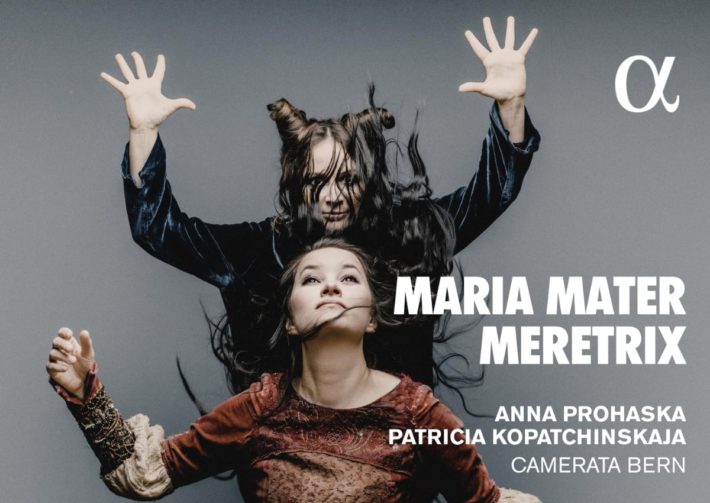An initial glance at the track listing of this album invites a good bit of curiosity: there is a millennia’s worth of music from Hildegard von Bingen to George Crumb. The featured composers are just as varied and include an anonymous work, though György Kurtàg makes several appearances. Soprano Anna Prohaska and violinist Patricia Koparchinskaja actually explain this diversity as a “theoretically stringent” exploration of Woman from three different angles. From the musical standpoint, the program is a crescendo, generally moving from solos to duets and eventually fuller orchestral works. The aim is to show how starkly different eras and styles build a world through sound.
What’s quite interesting is that within the larger architecture of the program are smaller-scale but equally effective pairings of works. For instance, George Crumb’s ‘Return, God-Land’ from his Black Angels String Quartet (track 3) is juxtaposed with Guillaume Dufay’s Ave Maris Stella (arr. Michi Wiancko). Delicate, esoteric, and exposed, the Crumb requires a lot of nuance. A significant part of its haunting character comes from unique instrumentation: water-tuned glasses. The good execution here creates that scintillating yet spine-tingling glass harmonica effect. Against this backdrop is the solo violin. Koparchinskaja breathes a lot of life into the part, and the instrument whispers, sighs, and wails. At around 2’30”, for instance, we can sense the emphatic push on the strings, which makes for a convincing and emotionally charged high point. The ending, whose extended notes are barely at a pianissimo, shows her excellent bow control. The clever common denominator going into the Dufay are the water glasses. And though strings sound a bit rickety when they appear, the strong effort of the brass section later on makes up for it.
A pairing of Hildegard von Bingen with Haydn may not immediately come to most minds, but Prohaska and Koparchinskaja make a deft—and illuminating—coupling of O Rubor Sanguinis (track 13) with “Il Terremoto” by way of tonality. An E pedal point in the Gregorian chant is an appropriate and organic lead-in to E major. Texturally, the juxtaposition also makes sense: von Bingen’s Gregorian chant, which of course places primary focus on the voice, feels like an introductory cadenza and Prohaska’s silky melismas come through beautifully. The purely orchestral Haydn serves then as a complement and introduces an arrival when the filled out harmonies reveal the major key. The Camerata’s fine playing lends a full sound but also a lovely sense of transparency to all the lines and parts.
Related Classical Music Reviews
- Review: Préludes, Interludes, Postludes – Jan Michiels, Piano
- Review: “Labyrinth” – David Greilsammer, Piano
- Review: Barbara Hannigan – “La Passione”
On a more dissonant note is Part 4 of Kurtàg’s Kafka-Fragmente (track 15). Part 1 appears earlier (track 7) with a more subtle, unsettling feel. This chapter is an escalation, and Prohaska and Koparchinskaja capture the jarring tension. The soprano’s acrobatic and angular line is full of clean pitches while the violinist’s articulation is equally detailed and neat.
For those wanting a (slightly) more tonal but still harmonically adventurous work, hear Lili Boulanger’s Pie Jesu (track 11). In another convincing showing, the Camerata creates a lot of character. The chromatic woodwind patterns are perfectly balanced and give a sense of endless wandering; the strings, meanwhile, create an array of moods from dreamy to ominous. While Prochaska sings her line beautifully like a doleful lullaby, the ever-changing backdrop helps evoke many dynamic transformations. The sense of harmonic arrival doesn’t really come until the end, and even then, it still feels somewhat ambiguous—a most appropriate invitation to keep on listening.
The only major drawback involves not the music but the included song texts: instead of the English versions placed side-by-side with the originals, they come after. With the booklet layout, this arrangement does not work and proves rather confusing and frustrating.
What’s clear in both the programming and performances is that Prohaska and Koparchinskaja have put a lot of thought into the album’s thematic construction; they have also used their musical versatility to bring its effectiveness to maximum fruition. While the liner notes describe some of their design, they don’t spill all the details. Part of the joy of listening to this album is therefore exploring the more hidden facets. The stellar artistry here only makes that journey all the more enjoyable.

Maria Mater Meretrix
Anna Prohaska – Soprano
Patricia Koparchinskaja – Violin
Camerata Bern
Alpha, CD ALPHA739
Related Albums
Read more classical music reviews or visit The Classic Review Amazon store
Follow Us and Comment:
Get our periodic classical music newsletter with our recent reviews, news and beginners guides.
We respect your privacy.








